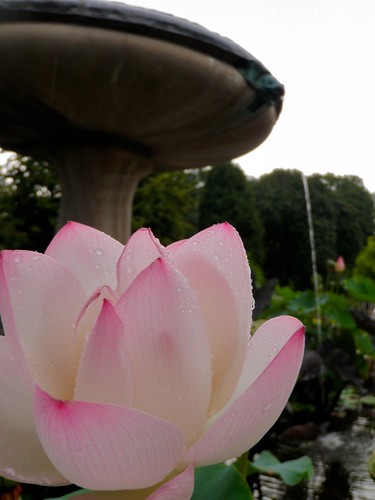 |
| Pink Lotus Flower - Brooklyn Botanic Garden |
The Brooklyn Museum is the country's second largest museum, following the Met, and contains 1.5 million pieces and the largest Egyptian collection in the Americas. It also has an Arts of Africa exhibit, including a few video loops offering a quick look into African customs, especially those surrounding the masks and costumes. On the second floor there were exhibits for Chinese, Korean, Japanese, Islamic, Indian, and Southeast Asian Art. The third floor was all Egyptian, but I will get to that later. The fourth floor I pretty much breezed through. It was all about fashion and had a bunch of clothes and shoes - no thanks, that is just not my cup of tea. The fourth floor also has some contemporary art, as well as (replicas of?) the interior of old houses that belonged to people who I have never heard of. The fifth floor included exhibits of American Identities and also the visible storage and study room.
 |
| Meditation - Brooklyn Museum |
Now, back to the third floor - the Egyptian rooms. I learned so much walking through the third floor, reading everything I could. The most interesting thing that I learned, that I had not already known, was about the positions of the statues. There are only about six different poses that you will see in Egyptian statues:
- Standing: One of the oldest poses, developed even before the Old Kingdom but remained popular throughout Egyptian history. Men are shown with their left foot advances and usually their fists clenched. Women are shown with both feet together or their left foot only slightly advanced and often hold objects or have their hands flat at their sides.
- Seated: This pose also dates back to before the Old Kingdom, when furniture was relatively rare, thus is associated with status and wealth. The Egyptian words for "nobility" and "wealth" are actually a hieroglyph showing a figure seated on a chair.
- Scribe: The scribe pose, a man seated on the ground with crossed legs, is usually shown holding a roll of papyrus spread across his lap. Being a scribe indicated the subject's education, and because education was highly valued by Ancient Egyptians, it also showed his prestige.
- Kneeling: This is considered a pose of worship or prayer, which is why most kneeling statues have been found in temples. Very few were made for non-royal people until the New Kingdom.
- Block: This pose almost always shows a non-royal figure, almost always a male, sitting on the ground, knees up, and arms folded to indicate patience. The figure is usually shown wrapped in a cloak on which inscriptions were often carved.
- Shawabti: These are small, shrouded, cross-armed funerary statues. They represent the deceased and were intended to do agricultural work in place of those persons in the afterlife - like little clones.
 |
| Stargazer Lily in Shakespeare's Garden |
Along with human mummies there were also mummies of animals! Animals were routinely mummified in the same way humans were and have been found in the tens of thousands in so-called animal cemeteries at a number of sites in Egypt. Pretty cool, if you ask me.
After my very interesting museum visit, despite the rain, I decided to head to the Brooklyn Botanic Gardens. Apparently not many people like being out in the rain, but I love it - ahh summer rain! It was great to have the gardens practically all to myself, and the rain stopped after about 15 minutes anyways. I took some really great photos and discovered that I absolutely love lotus flowers! I really wish that my friend Anne was there with me, though - she knows everything about everything when it comes to plants!
I took about an hour and a half stroll through the different gardens before closing time, and then I was back on the train heading home. Oh, and on the train there were these great performers doing dance and acrobatics - video posted below!
After my very interesting museum visit, despite the rain, I decided to head to the Brooklyn Botanic Gardens. Apparently not many people like being out in the rain, but I love it - ahh summer rain! It was great to have the gardens practically all to myself, and the rain stopped after about 15 minutes anyways. I took some really great photos and discovered that I absolutely love lotus flowers! I really wish that my friend Anne was there with me, though - she knows everything about everything when it comes to plants!
I took about an hour and a half stroll through the different gardens before closing time, and then I was back on the train heading home. Oh, and on the train there were these great performers doing dance and acrobatics - video posted below!
No comments:
Post a Comment